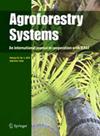Response of winter wheat yield components to the tree presence in a young alley-cropping system: What are the consequences for the soil mineral nitrogen content?
Abstract
We assessed the impacts of the tree presence on winter wheat (Triticum aestivum L.) yield components in a young alley-cropping focusing on the effects of tree canopy and its influence on soil mineral nitrogen. In 2019, 25-year-old small-leaved linden trees (Tilia cordata Mill.) with confined roots were transplanted within rows of one-year-old linden and willow trees (Salix alba L.) in alley crop and were compared with sole crop and sole tree plantation control plots at the Ramecourt alley-cropping experimental site in northern France. In 2023, the variability of wheat yield components and soil mineral N was analysed according to factors: tree canopy type, distance and orientation from the tree row, type of system and soil layer. Our results revealed that five-year-old trees had no significant impact on wheat yield or grain protein content. The canopy of old linden delayed the wheat maturity up to 3 m north of the tree row. The wheat spikes humidity measured twelve days before harvesting was negatively correlated with the total photosynthetic photon flux density under canopy (r = − 0.44; P < 0.01). The grains number per spike was the most significantly affected by the tree presence, especially 3 m from the old and the young linden to the north (P < 0.05). Young trees increased the soil ammonium nitrogen content in the topsoil and decreased the percentage of nitrate in the soil mineral nitrogen in all soil layers (P < 0.05) via mechanisms that need to be better understood.

 求助内容:
求助内容: 应助结果提醒方式:
应助结果提醒方式:


